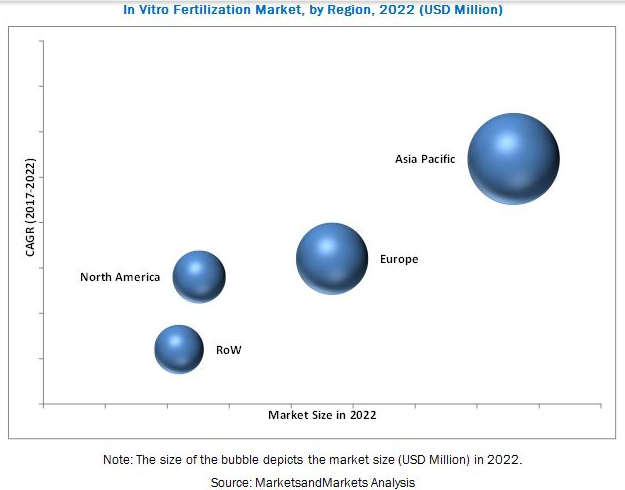The global in vitro fertilization market is projected to be valued at USD 465.2 Million in 2016 and is expected to grow at a CAGR of 10.9% from 2017 to reach to USD 847.8 Million by 2022.
The key factors propelling the growth of this market include growth in the median age of first-time motherhood, declining fertility rates, rising male infertility, rise in consumption of alcohol and cigarettes, and growing public awareness about infertility and the available treatment options. However, the high cost and low success rate of the IVF treatment and restrictive regulation and ethical concerns are expected to restrict the growth of market to a certain extent.
Base year considered for the report is 2016 and the forecast period is 2017–2022.
Download the PDF Brochure to Get More Information@ http://bit.ly/2xXnBs7
- To define, describe, and forecast the global in vitro fertilization market with respect to type of cycle, product, end user, and region
- To provide detailed information regarding the major factors influencing the growth of the market (drivers, restraints, opportunities, and challenges)
- To strategically analyze micro markets with respect to individual growth trends, prospects, and contributions to the overall market
- To analyze market opportunities for stakeholders and provide details of the competitive landscape of market leaders
- To forecast the size of the global market with respect to four main regions—North America, Europe, Asia Pacific (APAC), and the Rest of the World (RoW)
- To profile the key players in the global market and comprehensively analyze their core competencies
- To track and analyze competitive developments such as agreements and partnerships, mergers, acquisitions, reprocessed medical device developments, and service launches of the leading players in the in vitro fertilization market
CooperSurgical (US) dominated the In vitro fertilization market in 2017. It has a wide product portfolio of IVF media and assisted reproductive technology. The firm offers fertility products which include lab equipment, culture media, and micro tools. These products find applications in hospitals and surgical centers, obstetricians and gynecologists, medical offices, and fertility clinics.
To maintain its leading position and increase its customer base in the in vitro fertilization market, the company mainly focuses on expanding its market presence by adopting growth strategies such as acquisitions. For instance in 2016, CooperSurgical acquired Wallace Pharmaceuticals (India) to further strengthen its existing IVF product portfolio. CooperSurgical has its distribution facilities in Connecticut, Texas, and Denmark, along with diagnostic facilities located in multiple locations including California, Florida, Illinois, Michigan, New Jersey, Oregon, Texas, Canada, and the UK.
Cook Medical (US) held the second position in the In vitro fertilization market in 2017. The company primarily operates in Australia, Canada, Denmark, Ireland, and the U.S., and distributes its products across 135 countries. The company is engaged in manufacturing catheters, incubators, needles, culture media used in the area of reproductive health. The company’s impressive product portfolio is complemented by client support services offered by the firm. The company’s products cater to end users such as fertility clinics, hospitals, and surgical centers.
Vitrolife (Sweden) is another key player of the global In vitro fertilization market in 2017. Vitrolife develops, manufactures, and markets, products for assisted reproduction. Its fertility product area provides nutrient solutions (media) and advanced consumable instruments including needles and pipettes, for the treatment of human infertility.
In addition, the company offers a wide range of products for various procedures such as sperm preparation, oocyte retrieval, conventional IVF, ICSI, embryo culture, embryo transfer, vitrification, and slow freezing under its fertility segment. To maintain its leading position, the company focuses on business strategies such as product launches and acquisitions. For instance, in 2016, Vitrolife acquired OCTAX Microscience (Germany). Also, in 2016, the firm launched EmbryoScope+, an imaging system with an integrated incubator. The firm has its presence in the U.S., Denmark, Hungary, Australia, France, Italy, the UK, China, Sweden, and Japan.
Read the Detailed Article on “In Vitro Fertilization Market – Global Forecast to 2022”, Here..!
The major players in the in vitro fertilization market include CooperSurgical (US), Vitrolife (Sweden), Cook Medical (US), Irvine Scientific (US), and Thermo Fisher Scientific (US).
Target Audience:
- In vitro fertilization manufacturers
- In vitro fertilization distributors
- Healthcare institutions (hospitals, clinics, cryobanks)
- Research institutes
- Vendors/service providers




The global in vitro fertilization market, key factors propelling the growth of this market include growth in the median age of first-time motherhood, declining fertility rates, rising male infertility, rise in consumption of alcohol and cigarettes, and growing public awareness about infertility and the available treatment options